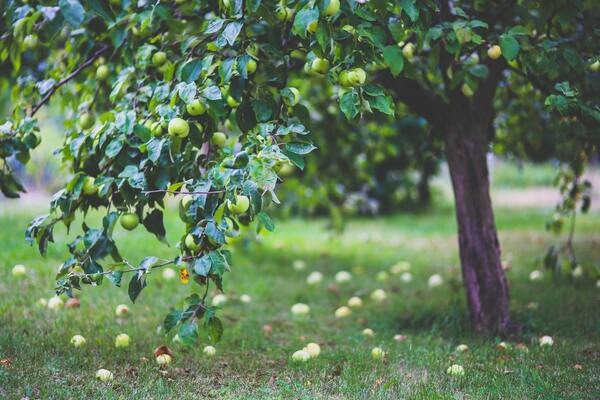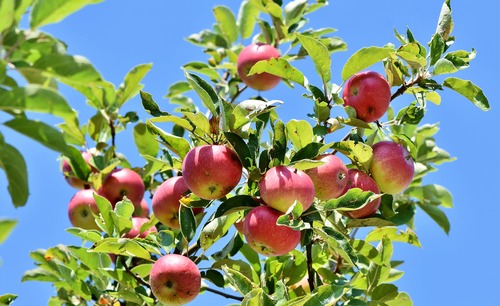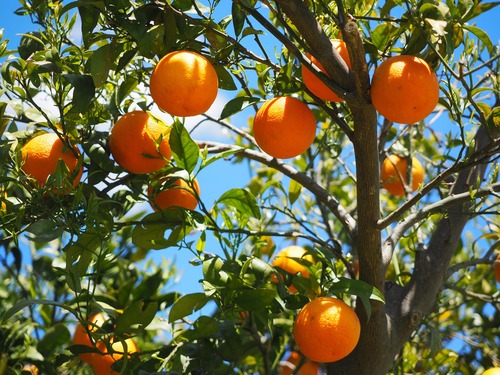Keeping Pests Away from Your Fruit Trees

Growing your own fruit trees is a significant commitment. It requires substantial investment in terms of money, time, and dedication to cultivate trees that will bear fruit for years to come. Given the hard work involved, it's crucial to protect these trees from pests and diseases. While no single method guarantees complete protection, several effective solutions exist. Let's explore the best options for fruit tree pest control.
Natural Pest Control for Your Fruit Trees

Apple Trees with minor pest damage
If you prefer handling fruit tree pest control without resorting to chemical sprays, here are some organic solutions. These methods are ideal for those who wish to avoid pesticides and prefer a more natural approach.
Bagging
One effective method is bagging, particularly useful for pests that burrow into fruit. This technique is highly recommended for apple trees, which are often plagued by apple maggots. It also works well for European pears (Pyrus communis ) and codling moths.
How to Bag Your Fruit
- Choose the Right Time: Begin bagging when the fruit is about the size of a marble, usually 4-6 weeks after bloom.
- Select the Bags: Use paper bags specifically designed for fruit or make your own from wax paper or brown paper lunch bags.
- Bag the Fruit: Place the bag over the fruit and secure it with a twist tie or staple.
- Monitor and Adjust: Remove the bags a few weeks before harvest to allow the fruit to develop its natural color.
Bagging protects the fruit from insects and reduces the need for chemical sprays. However, it can be labor-intensive and is best suited for small orchards or home gardens.
Sticky Traps
Sticky traps are another excellent option for managing fruit tree pests. These traps attract bugs with their bright, vibrant colors. Once the pests land on the trap, they become stuck. Sticky traps are easy to install and clean up, and they do not involve any pesticides or sprays.
Types of Sticky Traps
- Yellow Sticky Traps: Attract a variety of pests, including aphids, whiteflies, and fruit flies.
- Red Sphere Traps: Mimic ripe fruit and are particularly effective against apple maggots and cherry fruit flies.
How to Use Sticky Traps
- Select the Traps: Choose the appropriate color and type of sticky trap based on the pests you are targeting.
- Place the Traps: Hang the traps from branches or stakes at the height where pests are most active.
- Monitor and Replace: Check the traps regularly and replace them when they become covered with insects.
Sticky traps are a non-toxic and eco-friendly way to control pests, but they may not be sufficient for severe infestations.
Physical Removal
For some pests, the best solution is simply to remove them manually. The method depends on the type of pest. For example, aphids can be dislodged from your fruit trees with a strong stream of water from a hose.
Techniques for Physical Removal
- Water Spray: Use a hose to spray aphids, spider mites, and other small pests off the tree. This method is effective and safe for the tree.
- Handpicking: Remove larger pests, such as caterpillars and beetles, by hand. Wear gloves to protect your hands and place the pests in a bucket of soapy water.
- Pruning: Remove infested branches and dispose of them properly. This can help reduce pest populations and prevent the spread of disease.
Benefits and Drawbacks
Physical removal is a direct and immediate way to manage pests without chemicals. However, it can be time-consuming and may not be practical for large trees or extensive infestations.
Spraying Your Fruit Trees to Avoid Pests

Orange trees
When natural methods are not enough, various sprays can help control pests on fruit trees. These include chemical pesticides, oils, and microbial agents.
Oils
Oils are effective at suffocating insects, including their larvae and eggs. Dormant oil should be sprayed just before new growth appears in the spring to avoid damaging young shoots and leaves. Horticultural oil, neem oil, summer oil, and ultrafine oils can be applied later in the growing season. Note that oils should not be applied if temperatures exceed 90 degrees Fahrenheit, as this can harm your trees.
Types of Oils
- Dormant Oil: Applied before bud break to control overwintering pests and their eggs.
- Horticultural Oil: Used during the growing season to control a variety of insects, including mites and scales.
- Neem Oil: A natural pesticide that also has antifungal properties, suitable for use throughout the growing season.
- Summer Oil and Ultrafine Oils: Lightweight oils that can be used on sensitive plants without causing damage.
Application Tips
- Timing: Apply dormant oil in early spring before new growth appears. Apply horticultural, neem, and summer oils during calm weather to avoid drift.
- Coverage: Ensure thorough coverage of all plant surfaces, including the undersides of leaves, where pests often hide.
- Safety: Do not apply oils during high temperatures (above 90 degrees Fahrenheit) or to drought-stressed plants.
Microbial Agents
Microbial agents introduce microscopic organisms that are harmful to pests but safe for humans. These agents are an excellent choice for those who prefer a less toxic option.
Common Microbial Agents
- Bacillus thuringiensis (Bt): A bacterium effective against caterpillars and moth larvae.
- Beauveria bassiana: A fungus that targets a wide range of insect pests, including whiteflies, aphids, and thrips.
- Nematodes: Microscopic worms that infect and kill soil-dwelling pests like grubs and root weevils.
Application Tips
- Select the Right Agent: Choose a microbial agent specific to the pests you are targeting.
- Follow Instructions: Apply according to the manufacturer’s directions, paying attention to timing and environmental conditions.
- Monitor Effectiveness: Regularly check for signs of pest activity and reapply as needed.
Chemical Pesticides
Various chemical pesticides are available to control pests on fruit trees. Some of the most effective include:
- Acetamiprid: Ideal for controlling aphids, leaf miners, leafhoppers, apple maggots, codling moths, and plum curculio.
- Carbaryl: Effective against caterpillars, beetles, and predatory mites.
- Esfenvalerate and Permethrin: These can control a wide range of pests but may harm honeybees. To minimize harm to bees, apply these pesticides at dusk.
- Imidacloprid: Used to control borers and is applied at the base of apple and pear trees.
Choosing the Right Pesticide
- Identify the Pests: Correctly identify the pests affecting your trees to select the appropriate pesticide.
- Read Labels: Carefully read the labels to understand the application rates, safety precautions, and reapplication intervals.
- Environmental Considerations: Choose pesticides that are less harmful to beneficial insects and the environment.
Application Tips
- Timing: Apply pesticides at the right time in the pest life cycle for maximum effectiveness.
- Safety: Wear protective clothing and follow safety instructions to protect yourself and the environment.
- Avoid Bee Harm: Apply pesticides in the evening or early morning when bees are less active to minimize harm to pollinators.
Final Thoughts on Keeping Pests Away from Your Fruit Trees
We hope this information helps you protect your fruit trees from pests. If you need additional professional assistance, consider contacting a local landscaping service.
For residents in the San Mateo or San Francisco Bay Area, Arborist Now offers expert pest control services. Contact us today for more information and to ensure your fruit trees remain healthy and productive.
Originally posted on July 1, 2019.





